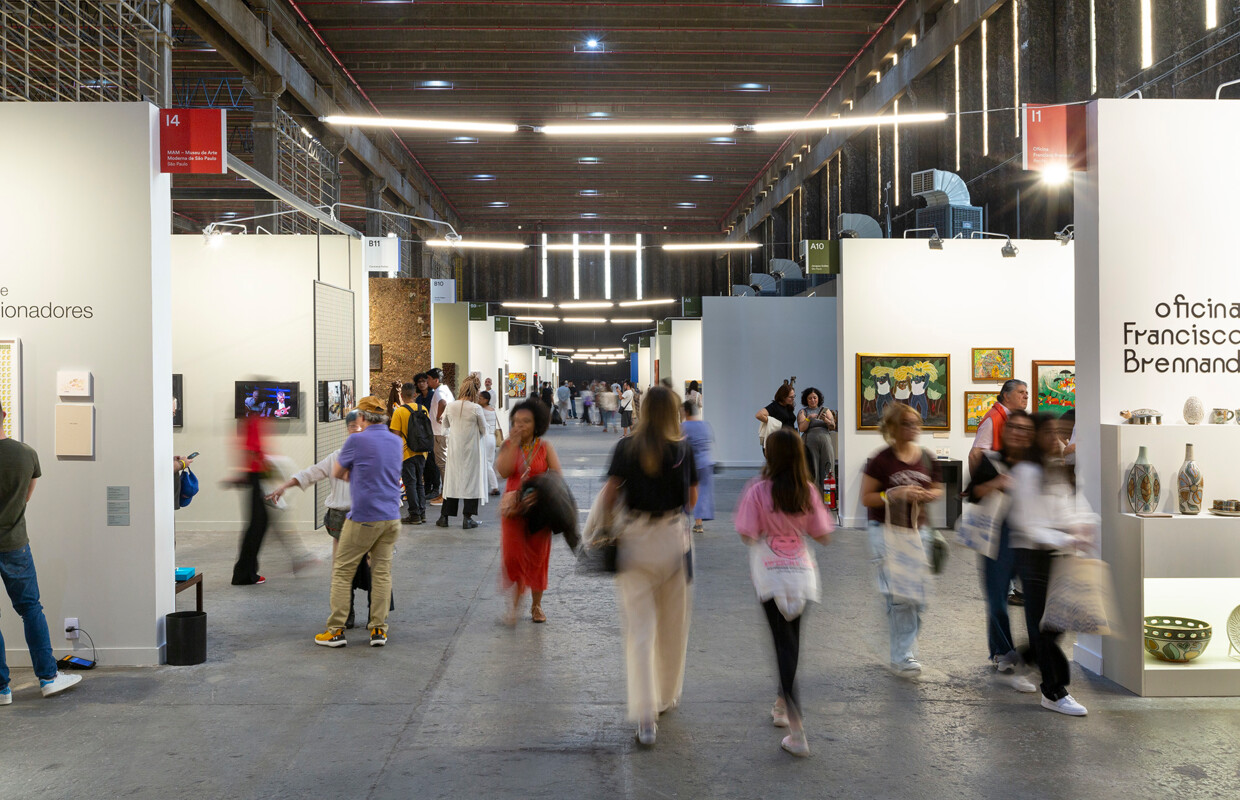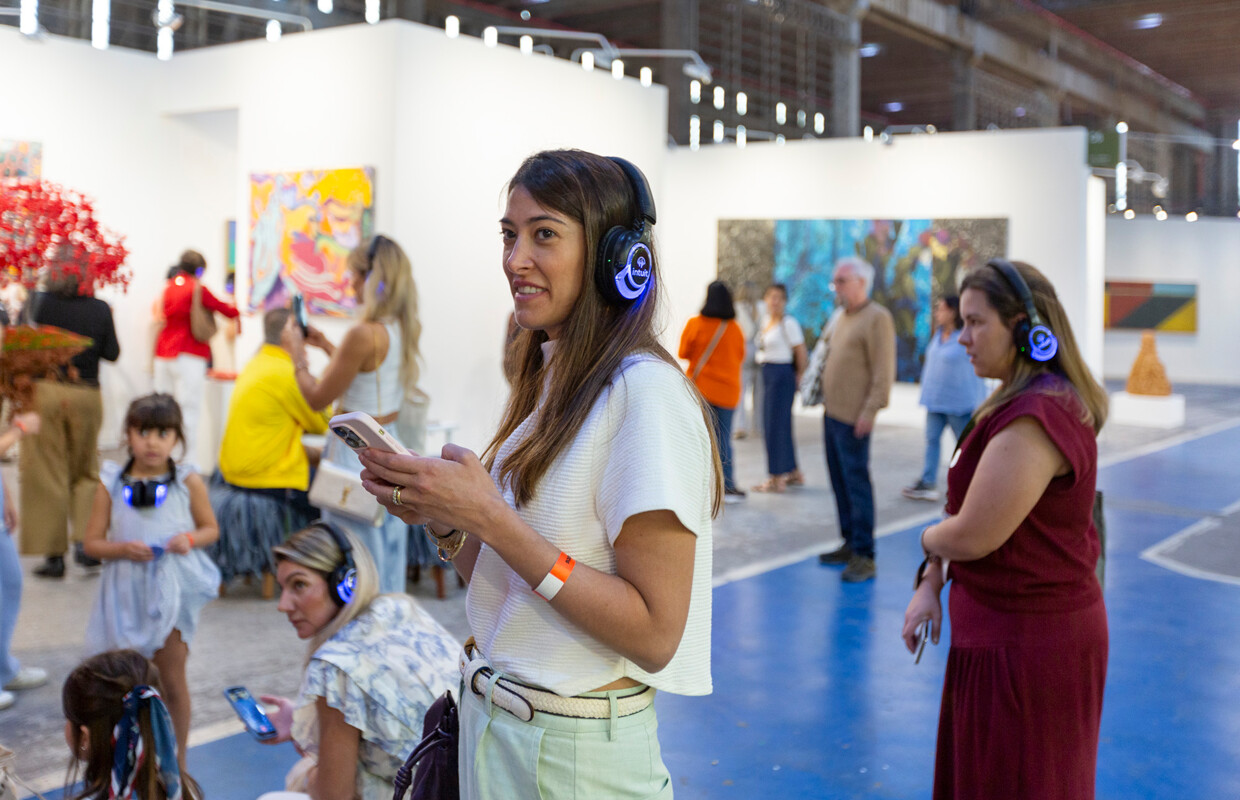Reimagining Brazilian Identity: Fernanda Feitosa on SP-ARTE's Rotas Brasileiras and the Future of Brazilian Art

SP-ARTE is a renowned producer of large-scale cultural events based in Sao Paulo, Brazil. Three major projects developed by the organization set a mission of promoting Brazilian artists and art industry workers nationally and internationally, while advocating for a universal access to art:
- SP-ARTE - Sao Paulo’s International Art Festival is a global art event held every year, since 2005, in Sao Paulo. During the event, galleries, artists, collectors and art lovers walk into the Bienal Pavilion to exchange stories, inspiration, and experiences. SP-ARTE is the biggest fair in modern and contemporary art in Latin America.
- Another successful project produced by SP–ARTE is their online platform that connects the Festival’s galleries to art collectors and buyers, while offering talented Brazilian artists a digital showcase to display their pieces and get attention from the world.
- Rotas Brasileiras (Eng. Brazilian Routes) is the newest initiative elaborated by SP-ARTE. The fair, whose first edition happened in 2022, is dedicated to “strengthening ties between the five regions of the country, valuing the diversity and the plurality of artistic production of the entire Brazilian territory”. This event is also a chance for artists residing outside of the Brazilian South and Southeast to familiarize the public with their creations and gain exposure among the country’s art market leaders.
Behind these projects is the mind of Fernanda Feitosa, Executive Director of SP-ARTE. She’s been heading the organization since day one. With the next edition of Rotas Brasileiras in full swing - it runs from August 28th to September 1st -, I talked to Fernanda about the fair and her expectations from the future.

This is the third edition of Rotas Brasileiras. What has changed since 2022?
It’s a fair that is young. Although we have a lot of experience and have been doing SP-ARTE for 20 years, Rotas is a new proposal, with a different idea and a different mission for the audience. It is a fair that is very much focused on its audience and their demand.
With each edition, we have different people visiting and exhibiting. Therefore, we’ve seen a very unique audience because [making it to] the venue is a [journey]; you need to drive there, and it has to be your final destination. It is different compared to SP-ARTE, which takes place in a location where there is an audience for other attractions, such as the Ibirapuera Park.
Rotas has gained a very loyal audience and continues to attract more visitors, as it consolidates. It is noticeable that it has become an event with a community committed to <...> a more attentive view of the plurality found in Brazilian art production.
Brazilian art is unique because of its diversity, both cultural and historical. Rotas seeks to bring this diversity by gathering a variety of cultural manifestations from different parts of the country, from North to South. These manifestations from each region differ in terms of style, theme, and technique. It is important to [hear] and bring together these plural voices that constitute our cultural production as a whole.
SP-ARTE - Sao Paulo’s International Art Festival is a well-established event in Brazil, promoting national artists with success. Was there any gap that the event couldn’t fill that led to the creation of Rotas Brasileiras? If so, which one(s)?
I have always been an advocate and admirer of small and medium events. Compared to Rotas, SP-ARTE is very large. At Rotas, we have 60 exhibitors, while at SP-ARTE, for example, we have 160, which is 100 more. So it seems very large, but it is also medium-sized compared to major international fairs.
SP-ARTE is a fair that is on the global calendar. Rotas has a different pace and timing, something more intimate. The visit occurs at a slower pace so that you can allow yourself to discover the novelties that the fair brings. I want people to also understand the proposal of the artists, the multiple voices that are speaking. Of course, SP-ARTE is a fair of multiple voices – any fair is a fair of multiple voices. I just think that Rotas is a fair where these voices are heard more loudly.
Rotas Brasileiras is a more intimate dive into what we call Brazilian art, and each visitor discovers their own Brazilian art at the fair. It is shaped by the very influence of the diversity found in the formation of Brazilian artistic production or the formation of national identity, [with] traces of international movements or colonization itself… influences from African roots, indigenous peoples, and populations from each region.
I do not say that other cultures do not have external influences, but it is noticeable that in Brazilian culture, these influences are much stronger and more remarkable.

Most of the exhibitors are based in Sao Paulo. I’ve lately found some problems when trying to contact art collectives from the North. Do you face the same difficulties as well when trying to reach galleries outside the Rio-SP zone?
I believe this is a somewhat inexorable reality. All development is concentrated in São Paulo. There is a lack of infrastructure in these cities, in regions outside the Rio-SP axis. There is no market infrastructure [for art], no socio economic infrastructure, and no economic power in these regions.
Above all, in our case, regarding art, there are still no consumer communities formed. So, to find an art collective or an art gallery in Roraima, for example, you need to be, perhaps, an art consumer in that state. And you still don’t find it. This is the reality of our country, where development is very concentrated in the South and Southeast, in many aspects, including cultural aspects, particularly in the consumer market.
There is artistic expression, but there is no established consumption in these regions that would allow for an art museum, an art gallery, or an art exhibition. I think events like the Bienal das Amazônias are extremely important for fostering cultural centers and art itself.
For instance, a gallery called Cerrado recently opened in Goiânia. You can imagine, there has never been an art gallery in Goiania. There was one, but in the 1980s. There was no consolidation of a community focused on the arts. Now, with the region's enrichment driven by agriculture, there are also social and cultural developments alongside economic growth. This also drives artistic development.
What is behind the idea of the audioguides?
We had a tradition of conducting guided tours at the fair. We would identify common themes and build the guided tour based on that. Then we noticed that these guided tours only benefited those who attended the fair in person. With the pandemic, we thought, “let’s continue with what we have but in audio format, so people can listen.” The pandemic came to an end, and we realized that the audio guides were much better than guided tours led by people.
In addition to allowing visitors to access that material before, during, and after the fair, our effort was no longer limited to an activity that would last such a short time. More than a thousand people download the audio, creating a broader reach. It makes sense to us because it contributes to greater accessibility and democratization of this content. It can also be accessed in text form; we put it in writing. For me, it is a timeless tool. And of course, the audio guide reflects the themes addressed at the fair.
The event offers programmes around the city too. What’s the main difference between them and the major event? How do communities engage with them?
Such events attract people's attention. The community gets involved, especially the partner galleries and museums. The galleries open their exhibitions a little before Rotas begins. Everything happens in such a way that during the five days leading up to the fair, the public feels encouraged to visit not only Rotas but also the participating galleries and museums and to engage with the artists.
We have a newsletter with 56,000 subscribers, through which we discuss the themes addressed in the exhibitions and what is happening in the art world in Sao Paulo and other locations. Throughout the year, we are in contact with this community of artists, curators, and art enthusiasts which is amazing… SP-ARTE is a platform for this community.

Is there anything in particular from the programme you would like to highlight personally? Something you're particularly looking forward to?
We are very curious to see how the positioning and impact of Mirante will be. Mirante is a new sector that we created at the fair, bringing together 15 Brazilian artists, envisioned by our artistic director Rodrigo Moura, who is also the curator of the Museo del Barrio in New York. Mirante will be located in the center of the fair, and it acts like a parabolic antenna that captures all national artistic expressions and looks to the future, the future of Rotas itself.
What do you envision and hope for the future of Rotas Brasileiras?
We are considering internationalizing and proposing other routes: affective routes, border routes, and routes connecting with the surroundings of Brazil, this grand country with communication routes to Mexico, Paraguay, Peru, Uruguay, and Chile, along with the countries in Latin region of South America. We have a lot of freedom to create and fill the gaps that we believe need to be addressed.
Do you wish to continue focusing on Brazilian artists?
I believe so. We can open up to the outside world, but for now, we are focused on national production. Rotas Brasileiras is about the honour and joy of being Brazilian. It is necessary to be open and engage in dialogue with the world, but a large part of the artists will always be Brazilian. It is possible to have a percentage of artists from outside, but the majority will be Brazilian.
The 2024 edition of Rotas Brasileiras ran from August 29 to September 1. Stay tuned to follow.art for our upcoming review and insights from the fair!
Share the post:














